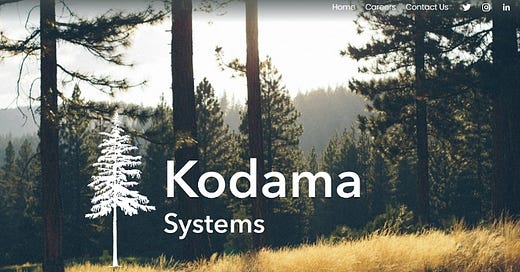Bill Gates, biomass burial, carbon credits, and fake news about 70 million acres of clearcuts
Biomass burial carbon credits anyone?
In their 1996 book, “Pulping the South”, Ricardo Carrere and Larry Lohmann considered a series of “stories for the uninformed public” that industrial tree plantation and pulp and paper industry proponents disseminate in order to ensure the constant expansion of their industry.
One of these stories for the uninformed is that “Fast-growing tree plantations can help curb global warming”.
They note that the area required would be vast. “The sheer scale of the plantations that would be required makes the idea politically and technically impracticable,” Carrere and Lohmann write.
And even if the plantations were established successfully, and remained standing for centuries so that they didn’t release the stored carbon back to the atmosphere, eventually they would stop sucking carbon out of the atmosphere and would reach a carbon equilibrium with the atmosphere.
“Faced with these challenges,” Carrere and Lohmann write,
“Some scientists have proposed deep-sixing huge masses of logs under ocean sediments after harvesting them, sequestering their carbon permanently, and then replanting the ground where they had grown, establishing a perpetual carbon sink.”
But they conclude that while “the elaboration of such techno-fantasies undoubtedly promises years of amusement for boffins” its unlikely to come to much because large areas of land would be needed, and it’s extremely unlikely that the pulp and paper industry or the timber industry would be willing to hand over their plantations to bury the wood under the ocean.
Fast-forward to 2022
In December 2022, MIT Technology Review reports that,
A California startup is pursuing a novel, if simple, plan for ensuring that dead trees keep carbon dioxide out of the atmosphere for thousands of years: burying their remains underground.
The startup is called Kodama Systems, Inc. It was incorporated in the tax haven of Delaware on 16 July 2021.
In December 2022, Kodama Systems raised US$6.6 million from Bill Gates’ climate fund Breakthrough Energy Ventures, Congruent Ventures and several other funders.
Superficially, it could appear to make sense. While trees grow, they suck carbon dioxide from air. But when they die and rot, they release that carbon. If the trees are buried and prevented from rotting, the carbon isn’t released.
But as James Temple, the journalist who wrote the MIT Technology Review article, points out,
Until it’s been done on large scales and studied closely, it remains to be seen how much it will cost, how much carbon it could store, and how long and reliably it may keep greenhouse gases out of the atmosphere.
Logging for fire prevention?
The source of Kodama’s timber is based on the myth that logging makes forests less vulnerable to wildfires.
Forests in the US have faced a series of major fires in recent years.
The U.S. Forest Service is planning to thin out 70 million acres of forests, mainly in California over the next decade. More than 1 billion tons of biomass will be removed.
But it’s far from clear that cutting down trees actually makes forests less likely to burn.
In 2021, the Dixie Fire burned down the town of Greenville, California. The forests around Greenville had been logged under the guise of creating “fuel breaks” to stop fires reaching the town.
Chad Hanson is the author of “Smokescreen: Debunking Wildfire Myths to Save Our Forests and Our Climate”. In a 2021 article for Grist, he writes that,
The Dixie Fire raced through many thousands of acres of these “thinned” forests before it razed much of Greenville.
Hanson writes that The Nature Conservancy has carried out extensive commercial logging operations in the Sycan Marsh “Preserve,” north of Beatty, Oregon. This logging is justified as “thinning”. But the Bootleg Fire in 2021 actually spread fastest through The Nature Conservancy’s lands that had been logged.
Kodama CEO Merritt Jenkins aims to “restore” forests. By logging them. He told GreenBiz that,
“The reason we need to restore these forests is we’ve actively suppressed wildfires for the past 100 years. Many forests are overstocked beyond their natural carrying capacity.”
Usually, the large logs from these logging operations are sold as timber. The undergrowth and smaller trees are piled up and either left to rot, or set on fire. The carbon returns to the atmosphere.
Kodama’s “wood vault”
Kodama aims to develop automated ways of thinning out forests, making the process cheaper and faster. But Temple notes that “it’s not yet discussed this part of the business in detail”.
Kodama will transport the branches, undergrowth, and anything else too small to be sold as timber to a “wood vault”.
In a pilot project in partnership with the Yale Carbon Containment Lab, Kodama plans to bury 4,500 tons of biomass in a mound 6.4 metres high, 2.7 metres deep, and 53 metres by 53 metres in the Nevada desert. Kodama estimates that the pilot project will remove 3,200 tons of CO₂.
The biomass will come from the Eastern Sierras, near Mammoth Lakes.
The biomass will be covered with a geotextile liner and buried under soil and a layer of native vegetation that the company hopes will absorb moisture. Kodama hopes to keep oxygen, termites, microbes, and water out of the wood vault thus preventing decomposition.
Problems, problems
Temple points out some of the potential problems:
The science of wood harvesting and storage is still evolving. We don’t fully understand what drives decomposition of wood.
Residents and environmental groups often oppose forest thinning in mature and old growth forests.
It will be difficult to automate forest thinning on steep slopes of dense forest.
Transporting the biomass and digging holes to store it in is expensive and uses a lot of energy.
And then there’s the problem of where all the biomass comes from. If demand for biomass burial takes off, it could create incentives to undertake large scale industrial logging operations.
And, of course, Kodama plans to sell carbon credits from its biomass burial projects.
Kodama hopes that its costs will be less than US$100 per ton of carbon. A company called Frontier will buy 415 carbon credits from Kodama, at a price of US$250,000, or just over US$600 each.
Frontier was founded by Stripe, Alphabet, Shopify, Meta, and McKinsey. It aims to spend US$1 billion on “permanent carbon removal” between 2022 and 2030.
So there’s plenty to criticise about Kodama’s operations. It’s promoting logging under the cover of fire prevention. It plans to bury biomass in “wood vaults” which it hopes will store the carbon permanently.
And it’s generating carbon offsets. Which is a massive distraction from the urgent need to leave fossil fuels in the ground, which is what we need to do to address the climate crisis.
Enter the fake news brigade
On 28 July 2023, Forbes published an article under the headline, “Chop Down Forests To Save The Planet? Maybe Not As Crazy As It Sounds”. The lede reads,
Bill Gates and other investors are betting Kodama Systems can reduce carbon dioxide in the air by chopping down and burying trees.
About a month later, a series of right-wing websites picked up on the story. And got it wrong. In this version of events, it’s not the U.S. Forest Service that’s planning to thin out 70 million acres of forests, it’s Bill Gates funding a plan to clearcut 70 million acres.
On 13 September 2023, AP put out a Fact Check article clarifying that “Bill Gates-funded climate change venture doesn’t call for razing 70 million acres of trees”.
Alex Reid, a spokesperson for Bill Gates told AP that, “These claims are false.”
Unfortunately, AP’s Fact Check fails to point out any of the actual problems with Kodama’s operations. It fails to explain the problems created by logging forests under the guise of “thinning” for fire protection. And it makes no mention of carbon credits.







Another scheme that avoids at ALL costs addressing the fundamental reality we must stop pumping carbon and methane into the atmosphere. As you point out, carbon sequestration by trees is at best temporary, the carbon WILL be returned to the atmosphere. Planting huge swathes of young trees does nothing for the immediate problem. It takes 20 to 30 years for a tree to mature to become a significant absorber of carbon. Additionally, promoting monocultural forests is harmful to failing biodiversity as the 6th extinction accelerates. Ridiculous stuff that's easy to foist off on the public and politically palatable.
I have commented on forest "thinning" at https://kathleenmccroskey.substack.com/p/all-your-forests-are-at-risk
To successfully "bury forests" you would have to waste even more energy to chip them to remove maximum entrained air. Is anaerobic combustion possible? That's how you make cyanide from wool. In any case, the oxygen in the CO2 in the trees MUST be returned to the atmosphere. Calling cutting and replanting of trees "sustainable" ignores the mass of mineral nutrients taken away with every "crop" of trees. A forest is not a large area of trees, it is a biome built by succession of plants resulting in a climax equilibrium. Hey, people, leave them trees alone! Burying forests under the ocean floor risks disturbing the buried methyl hydrates - you want to see REAL global warming, start messing those up! What fools these mortals be! Then there's Bill Gates with his new reactor design, never tried before, in the middle of Wyoming. If it's so safe, why so far from Microsoft campus?